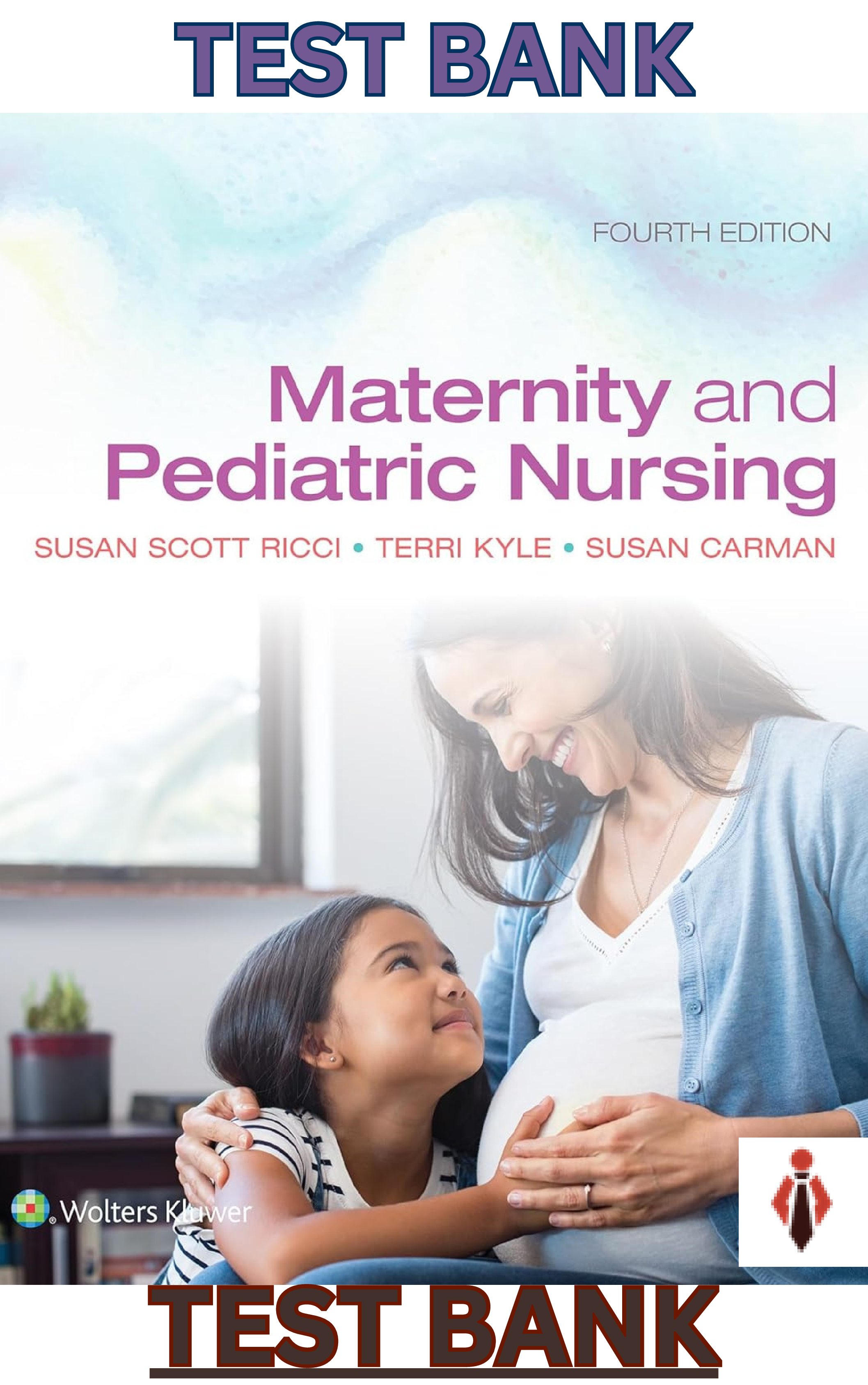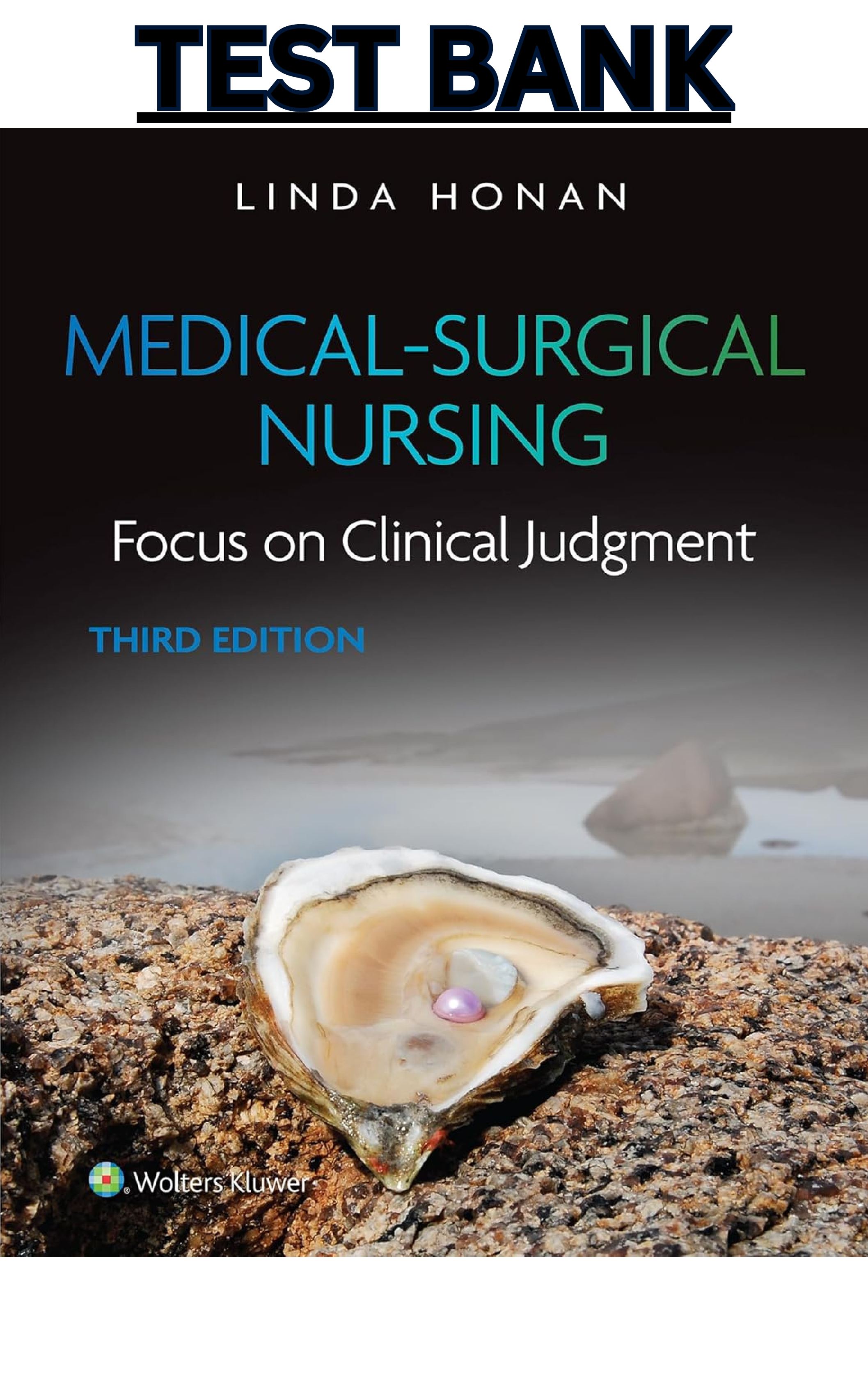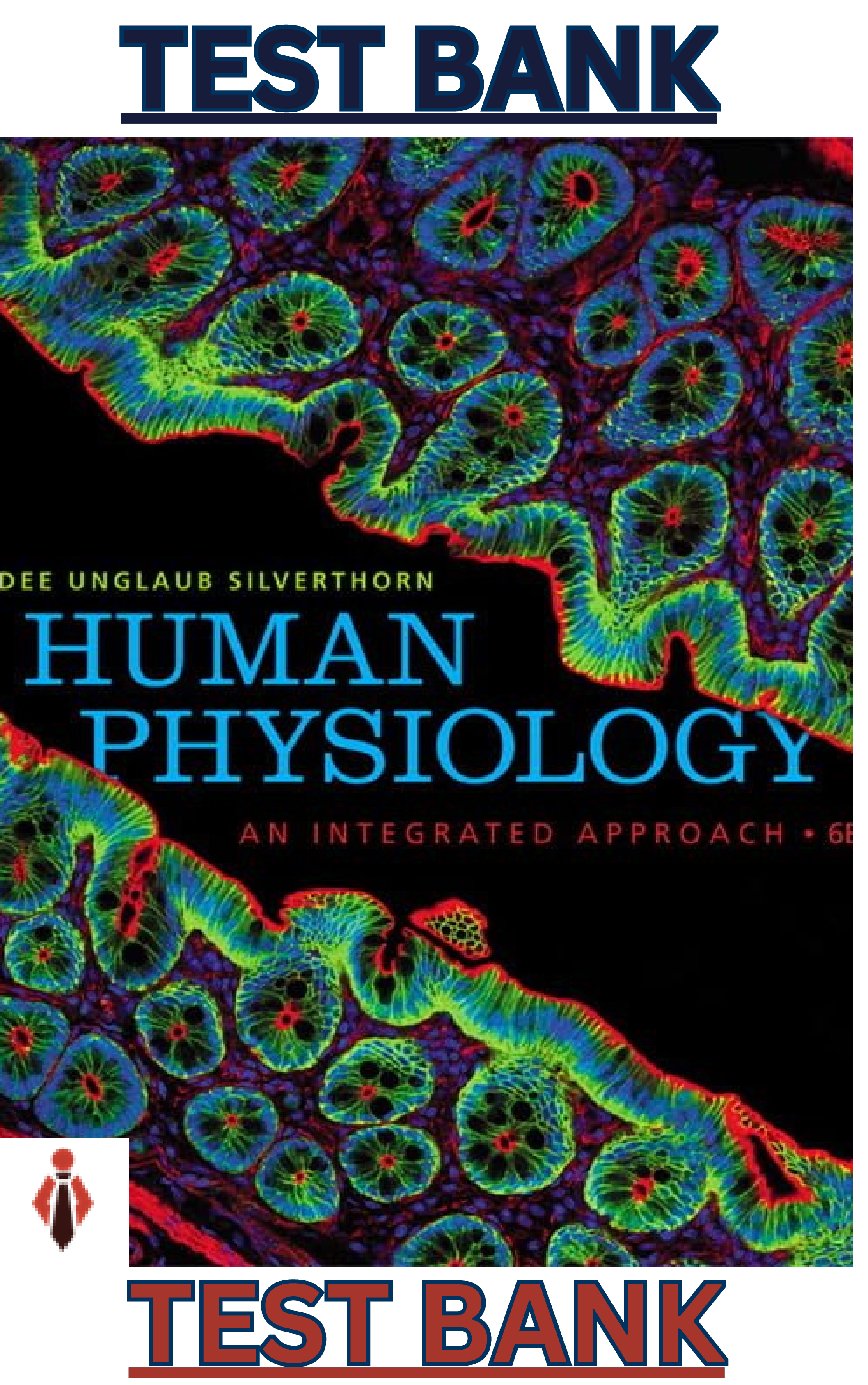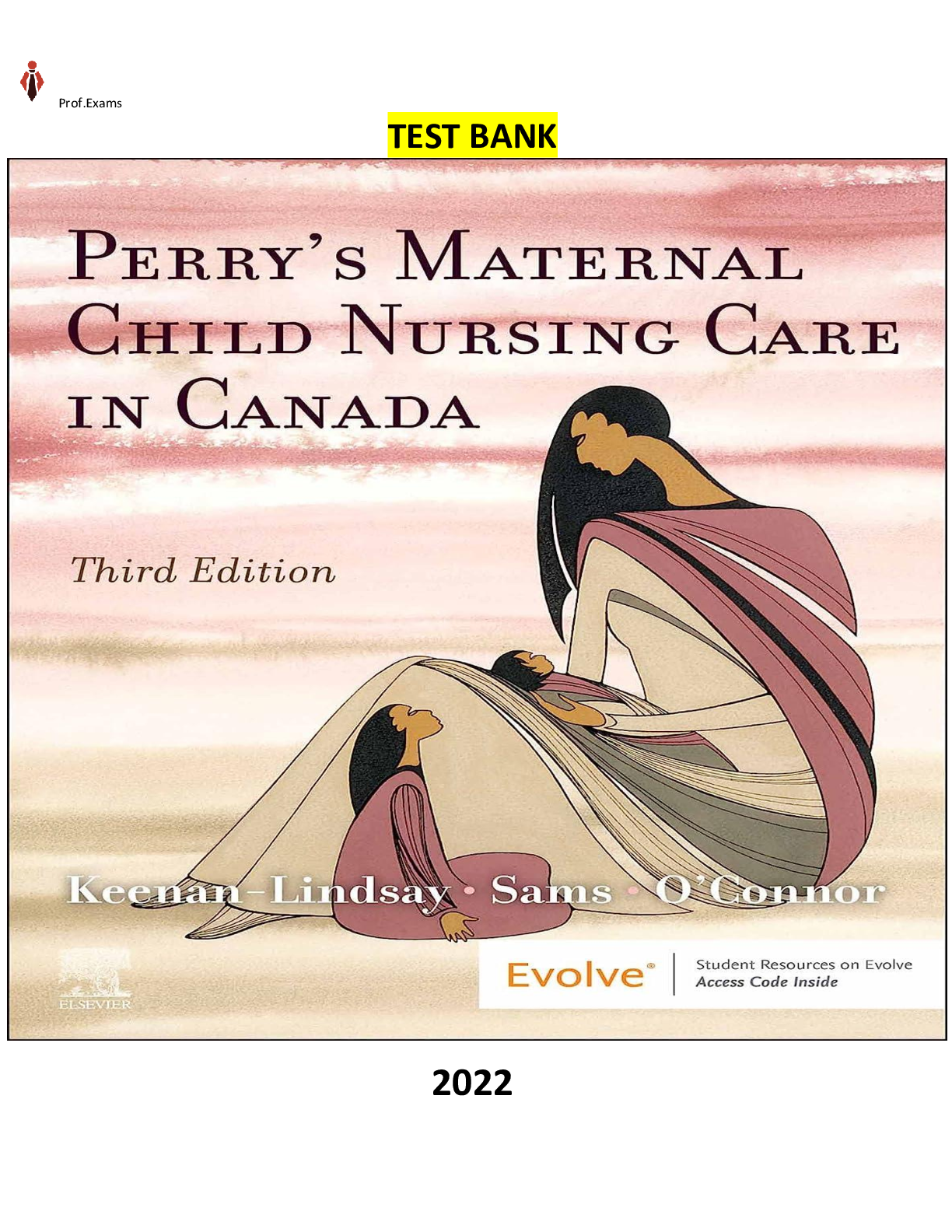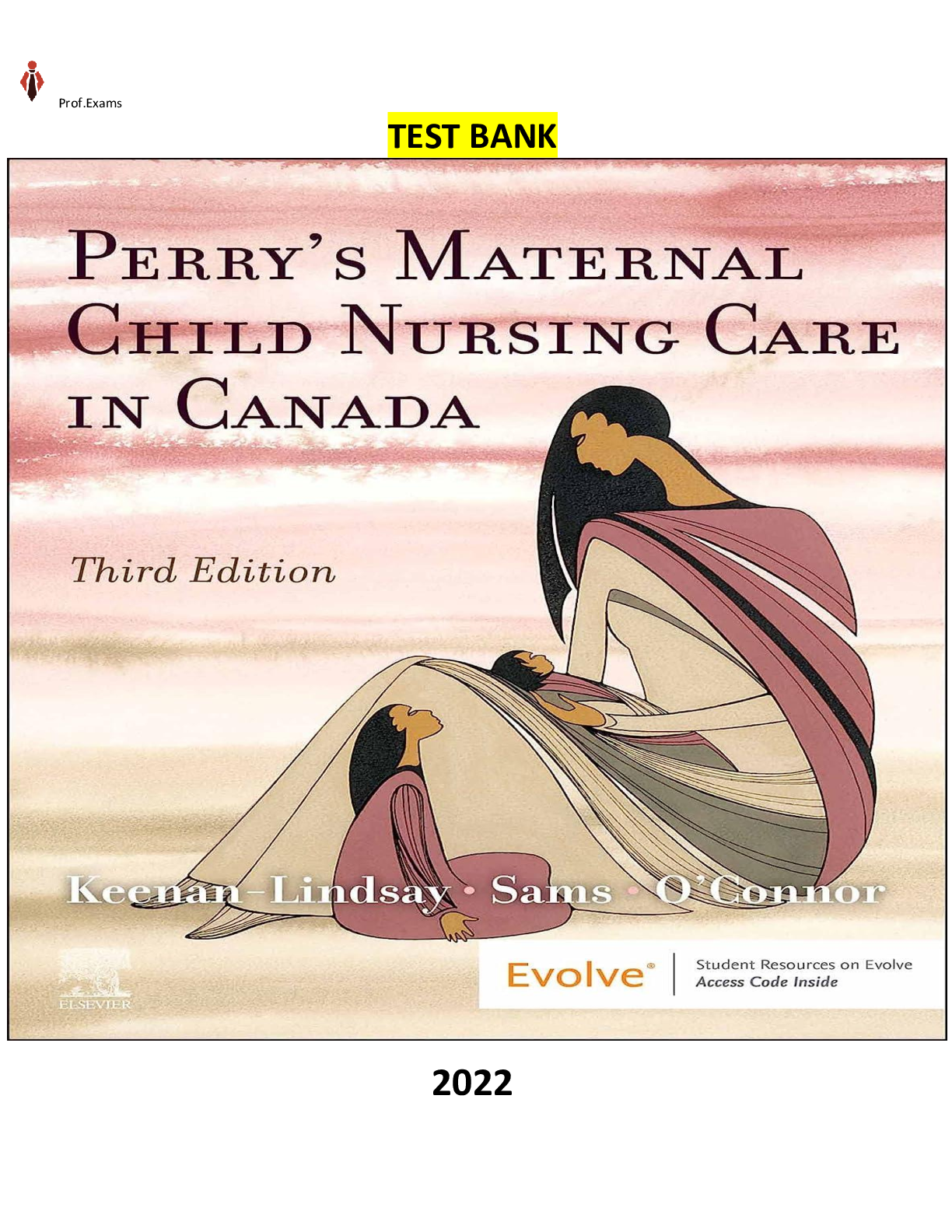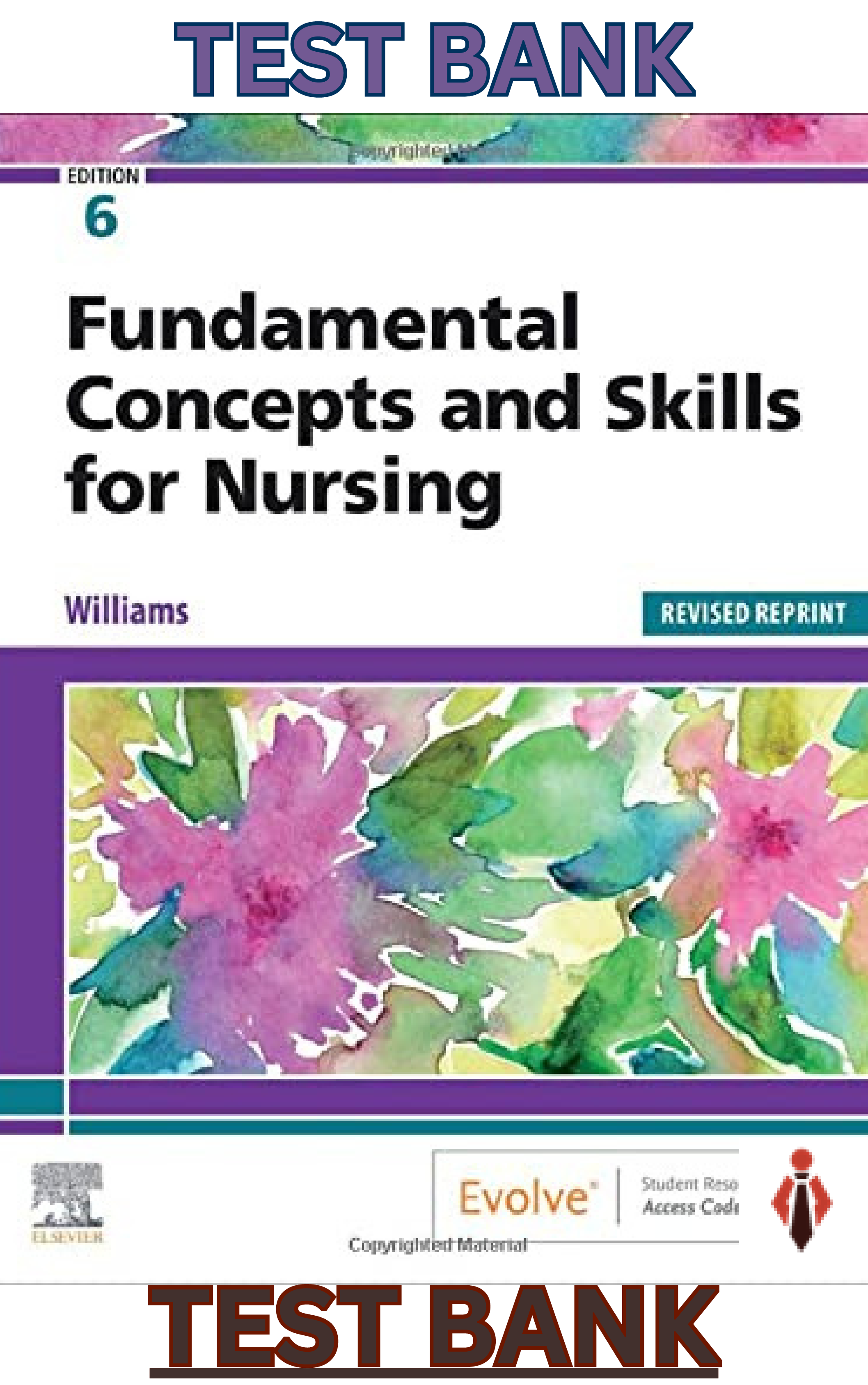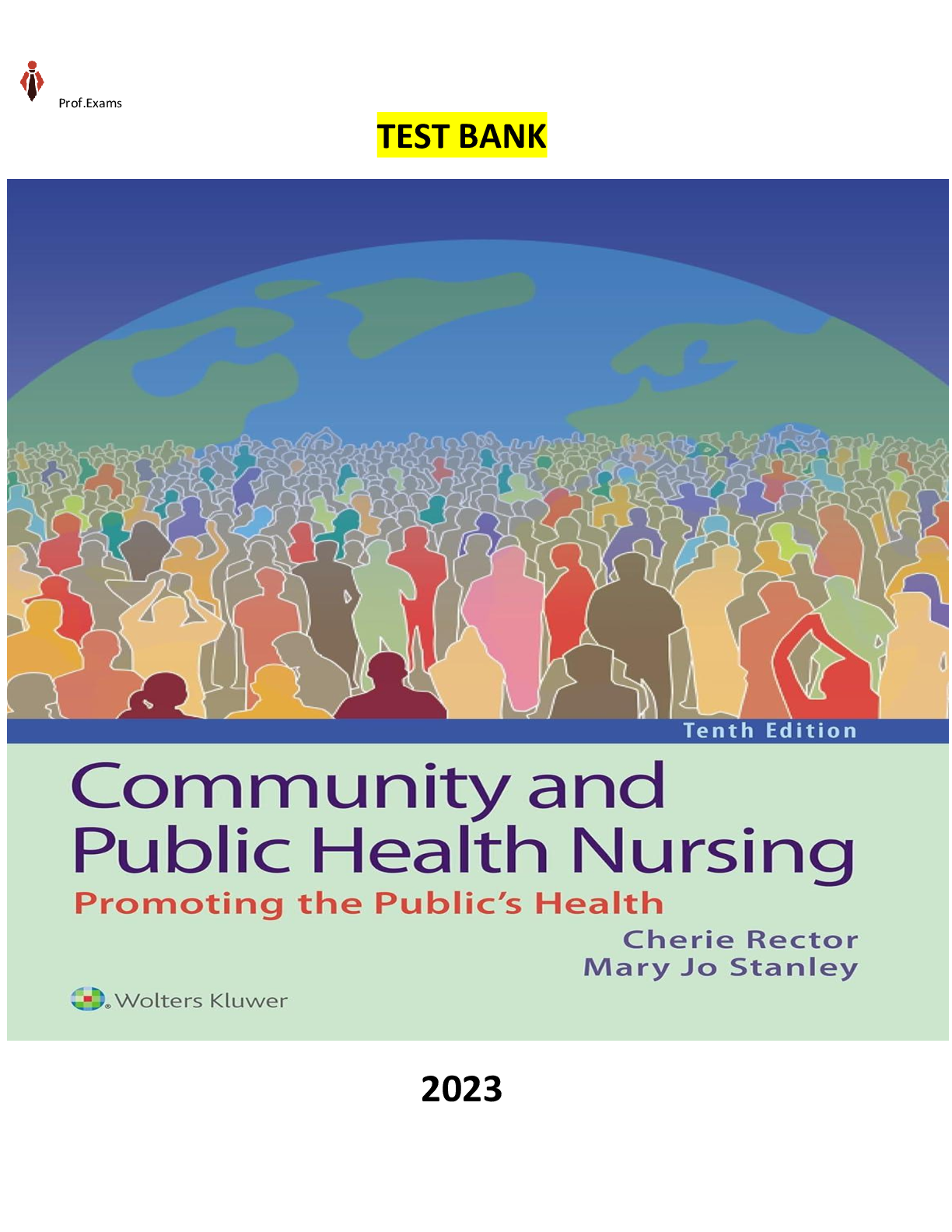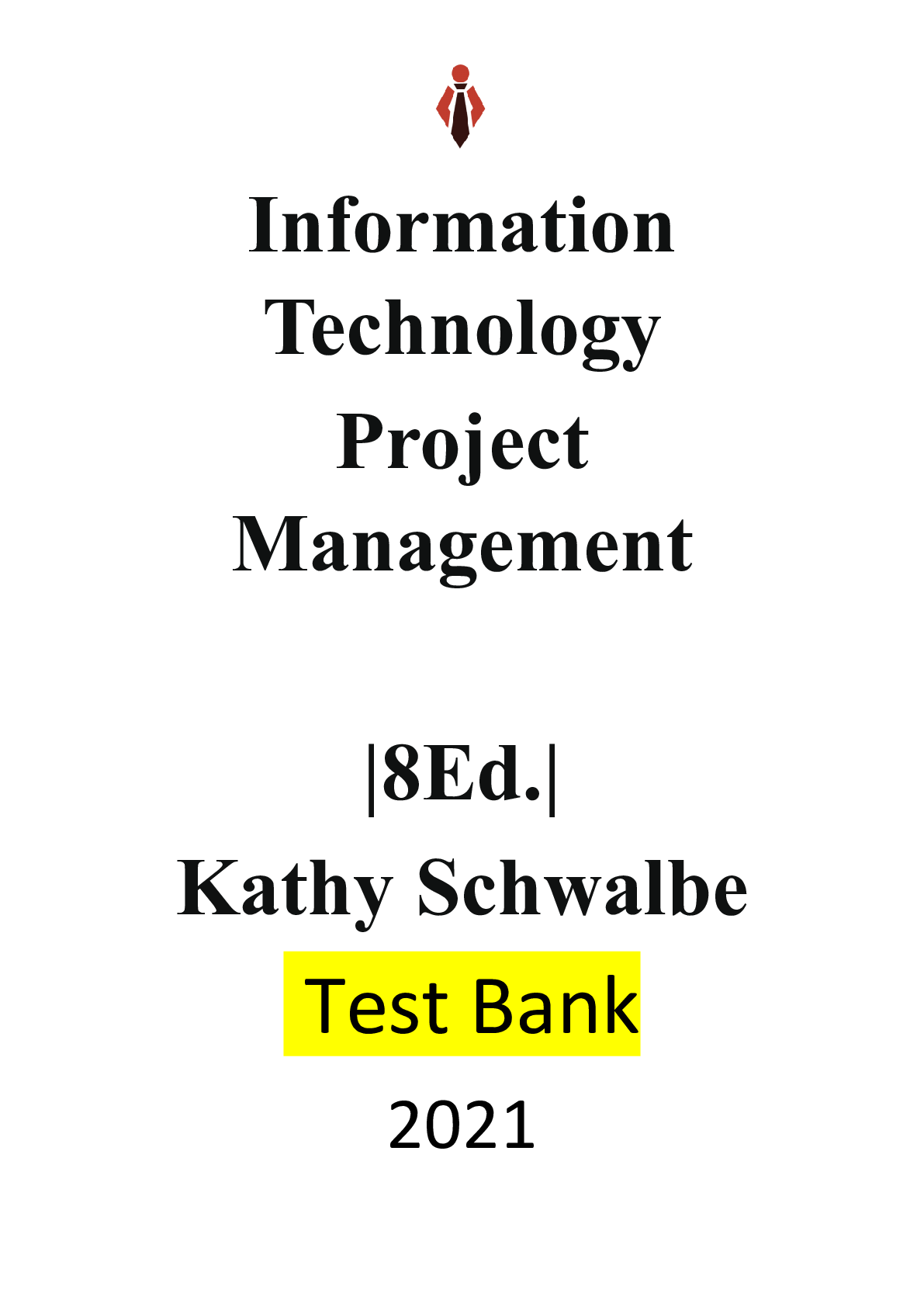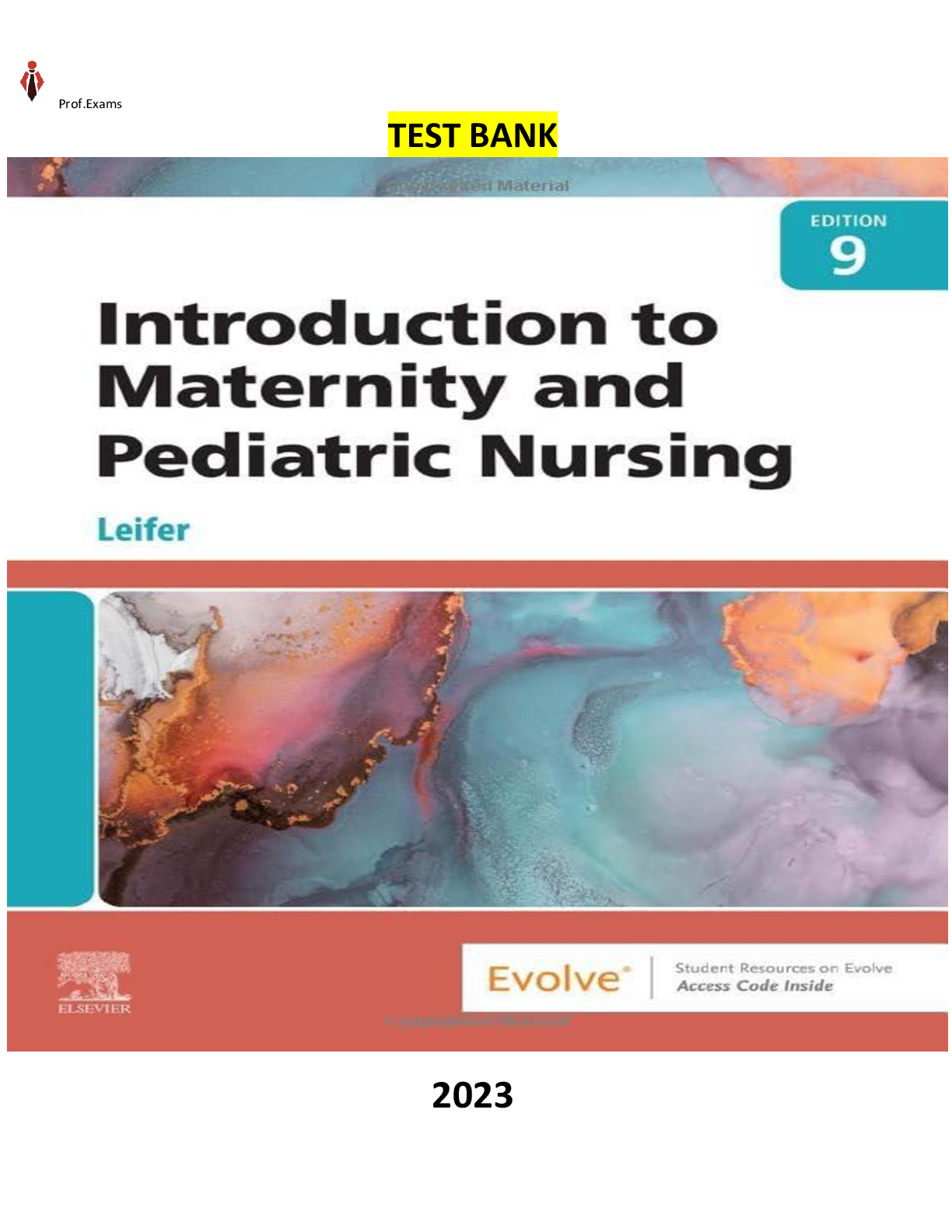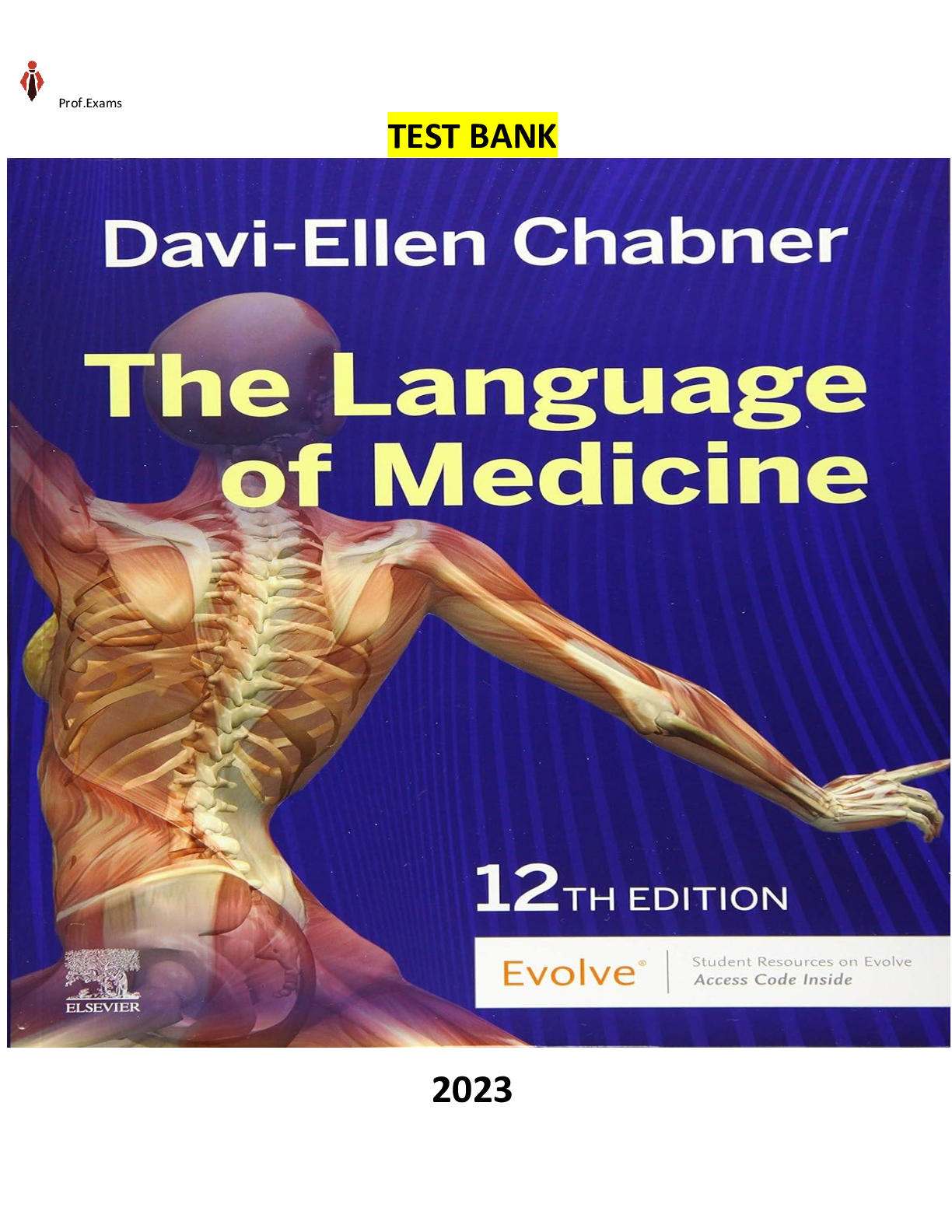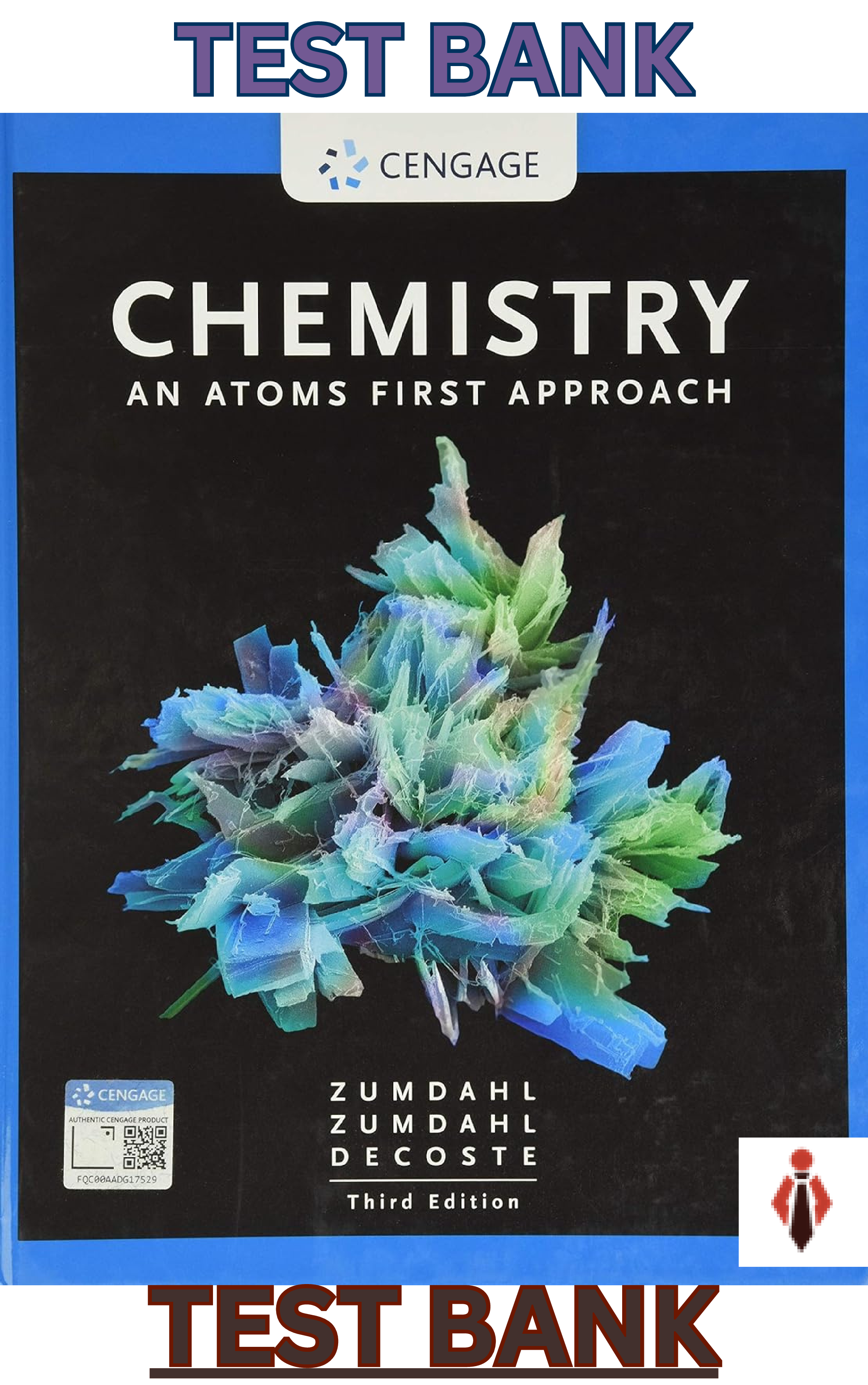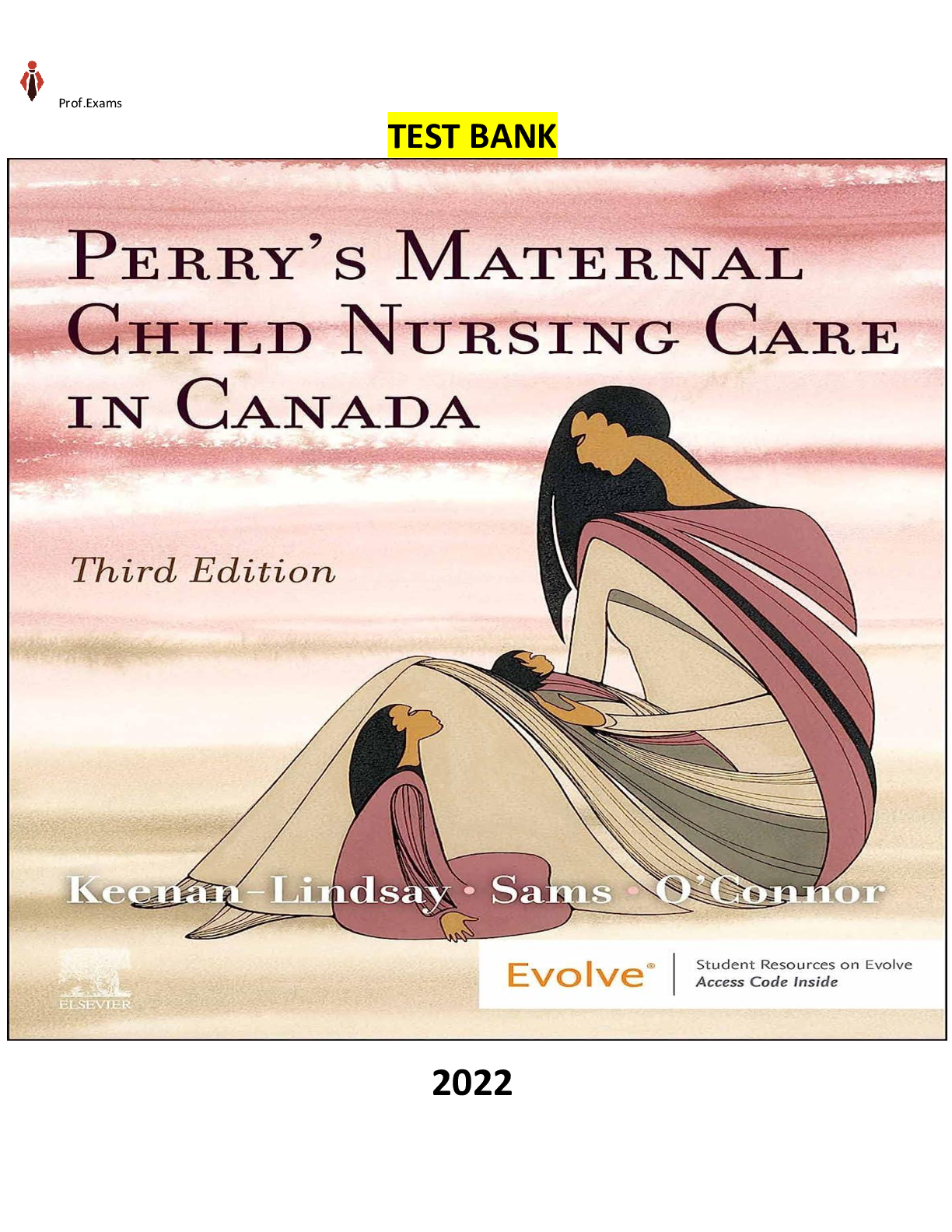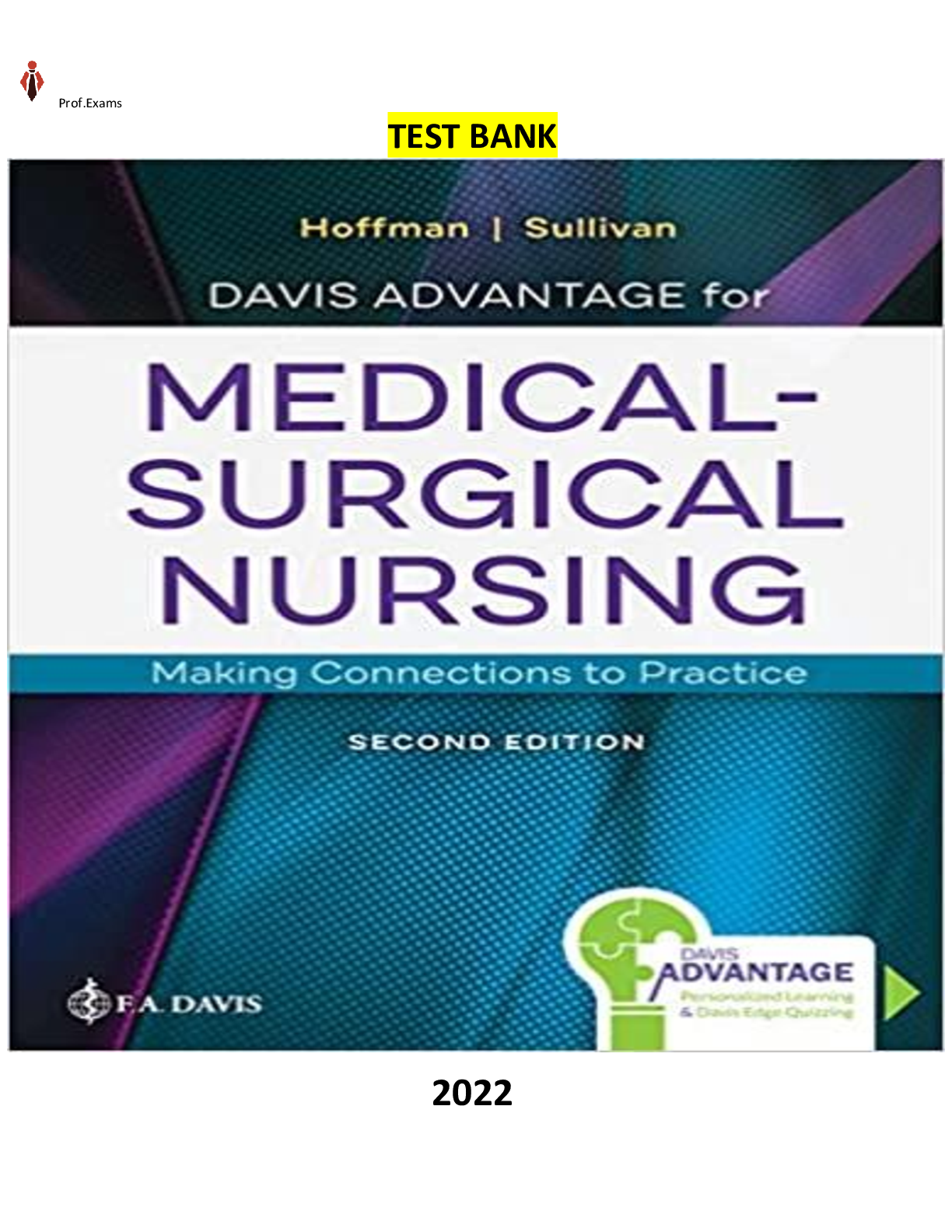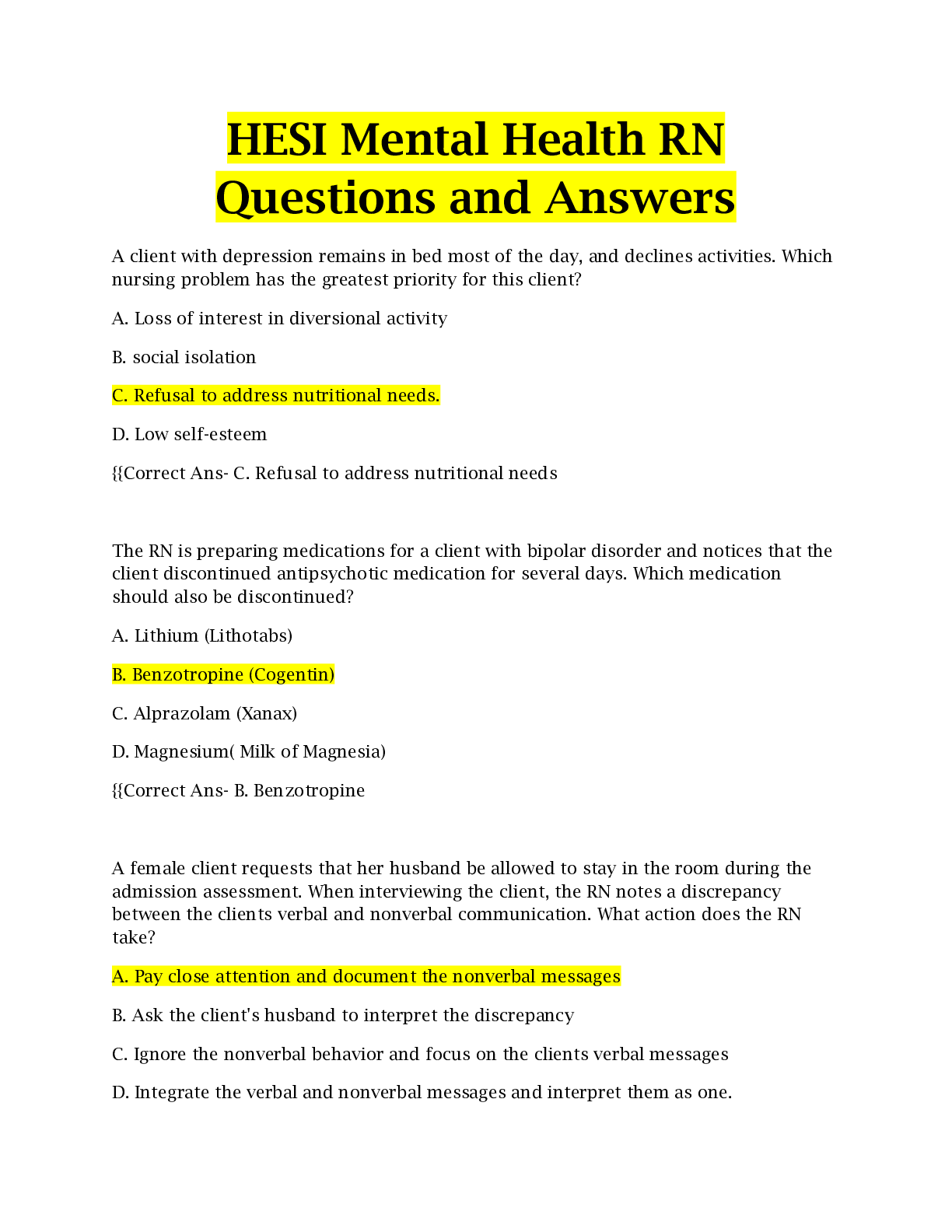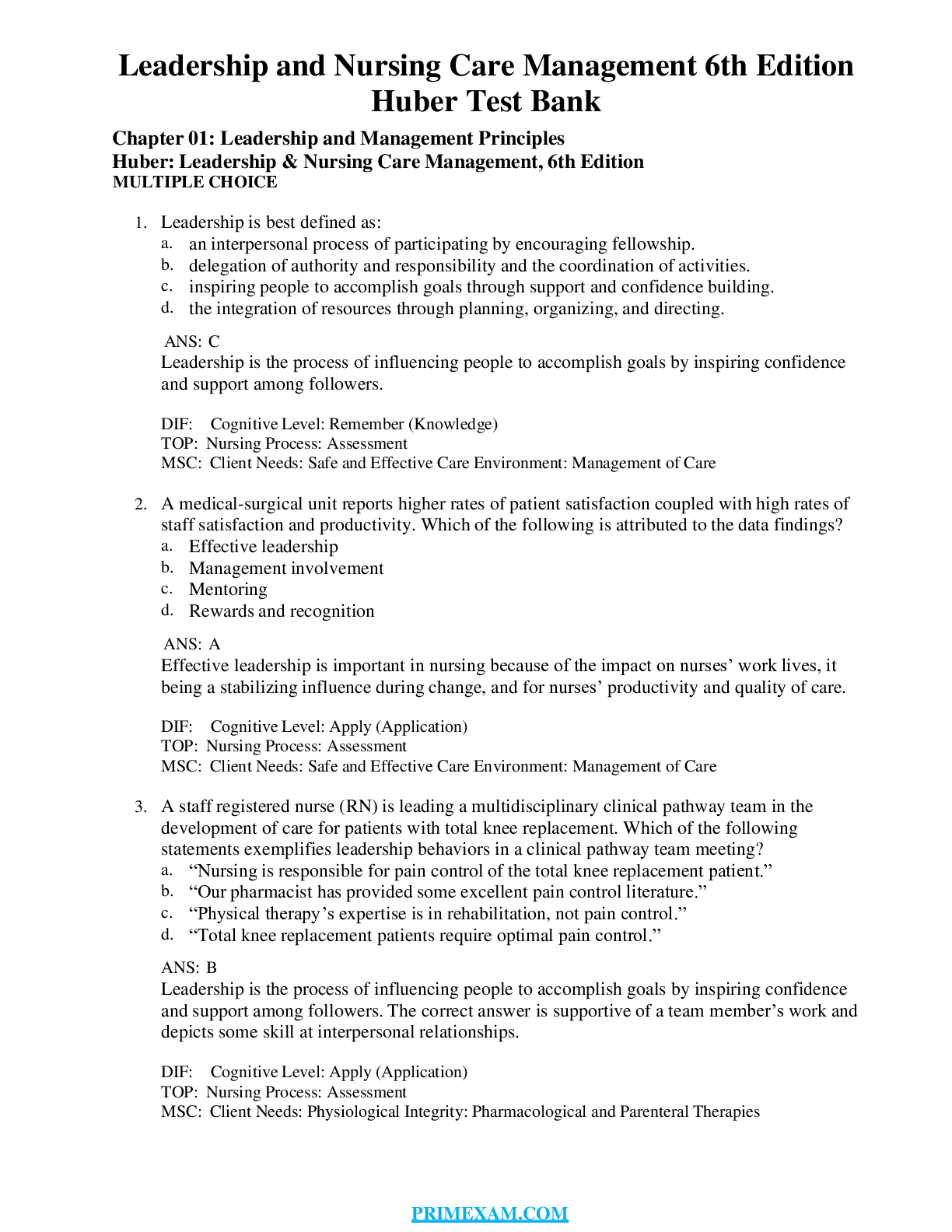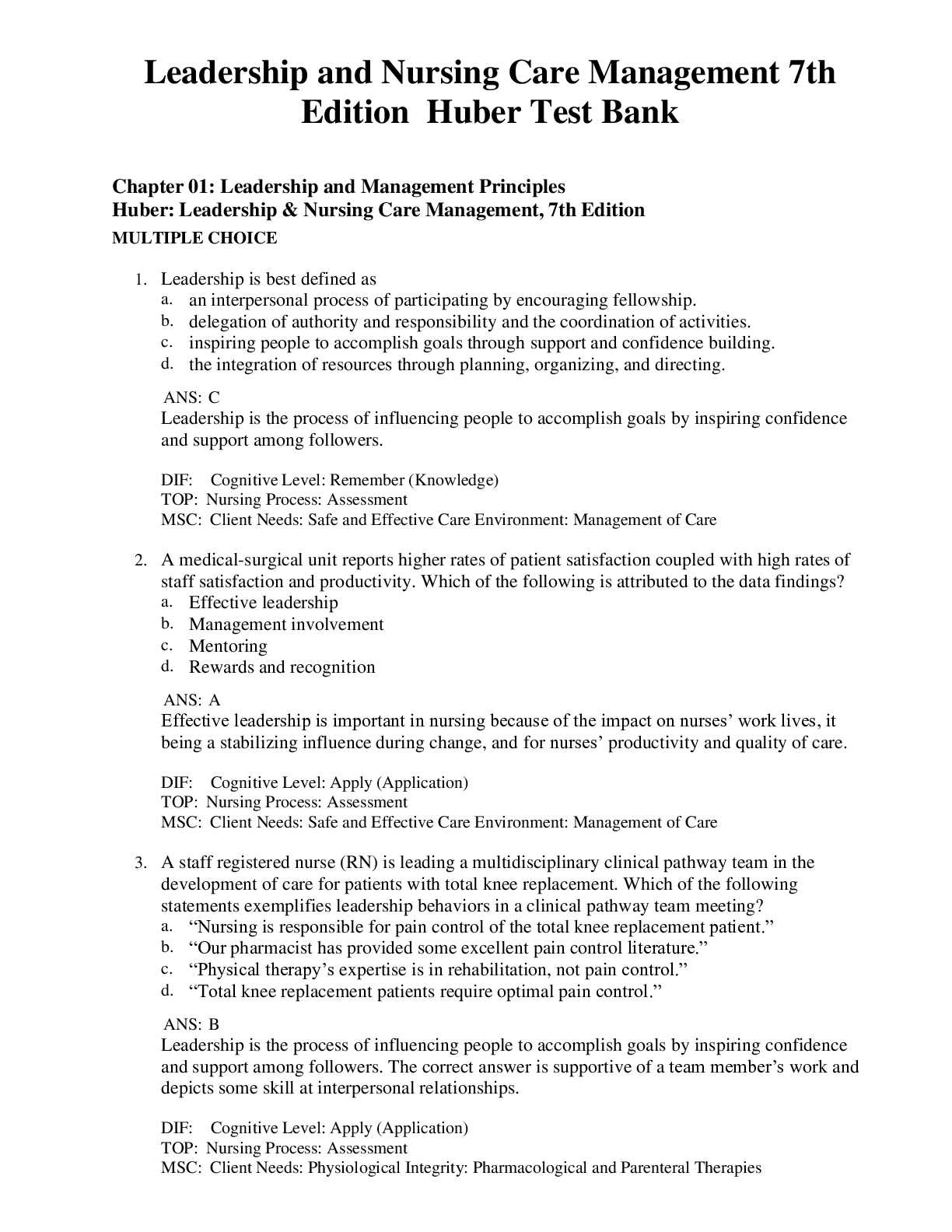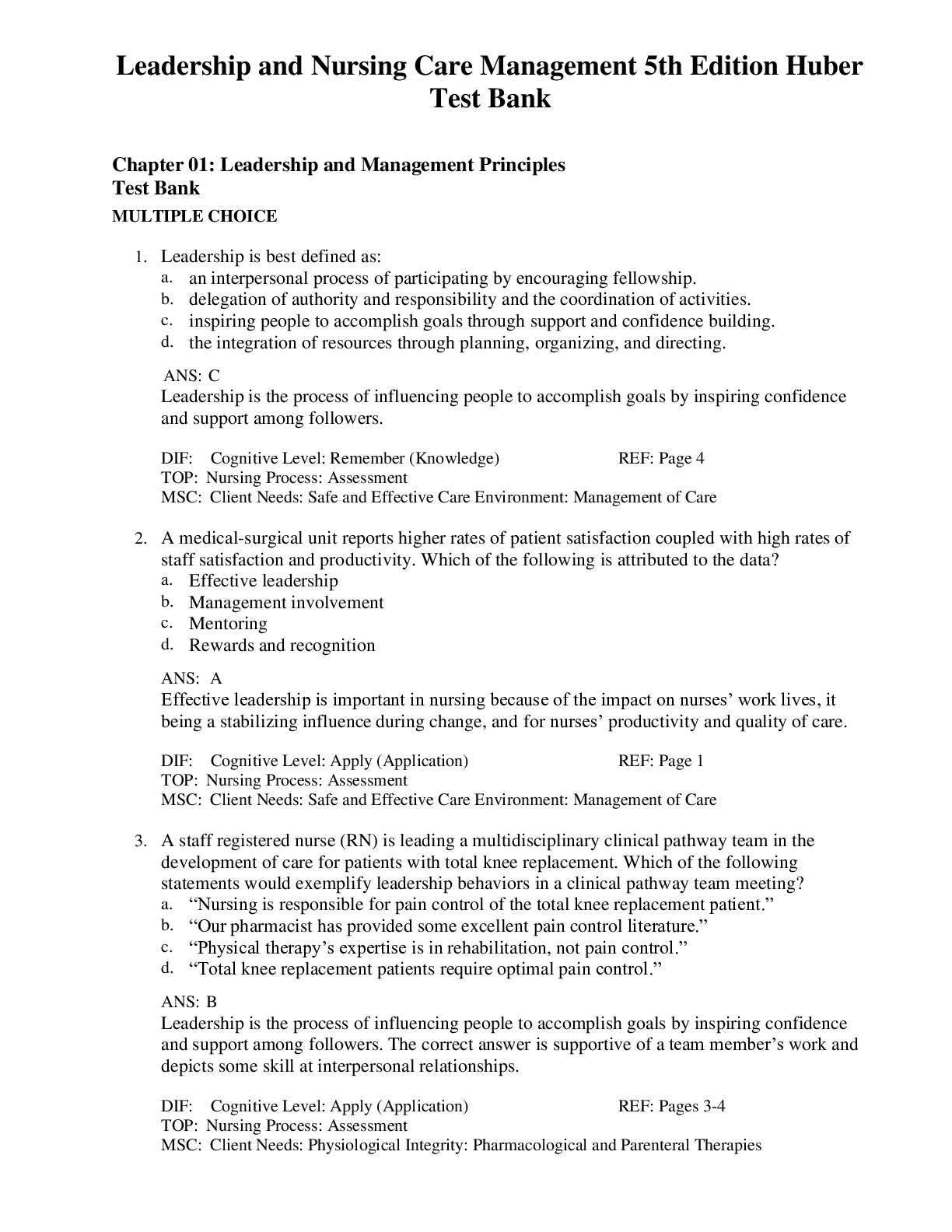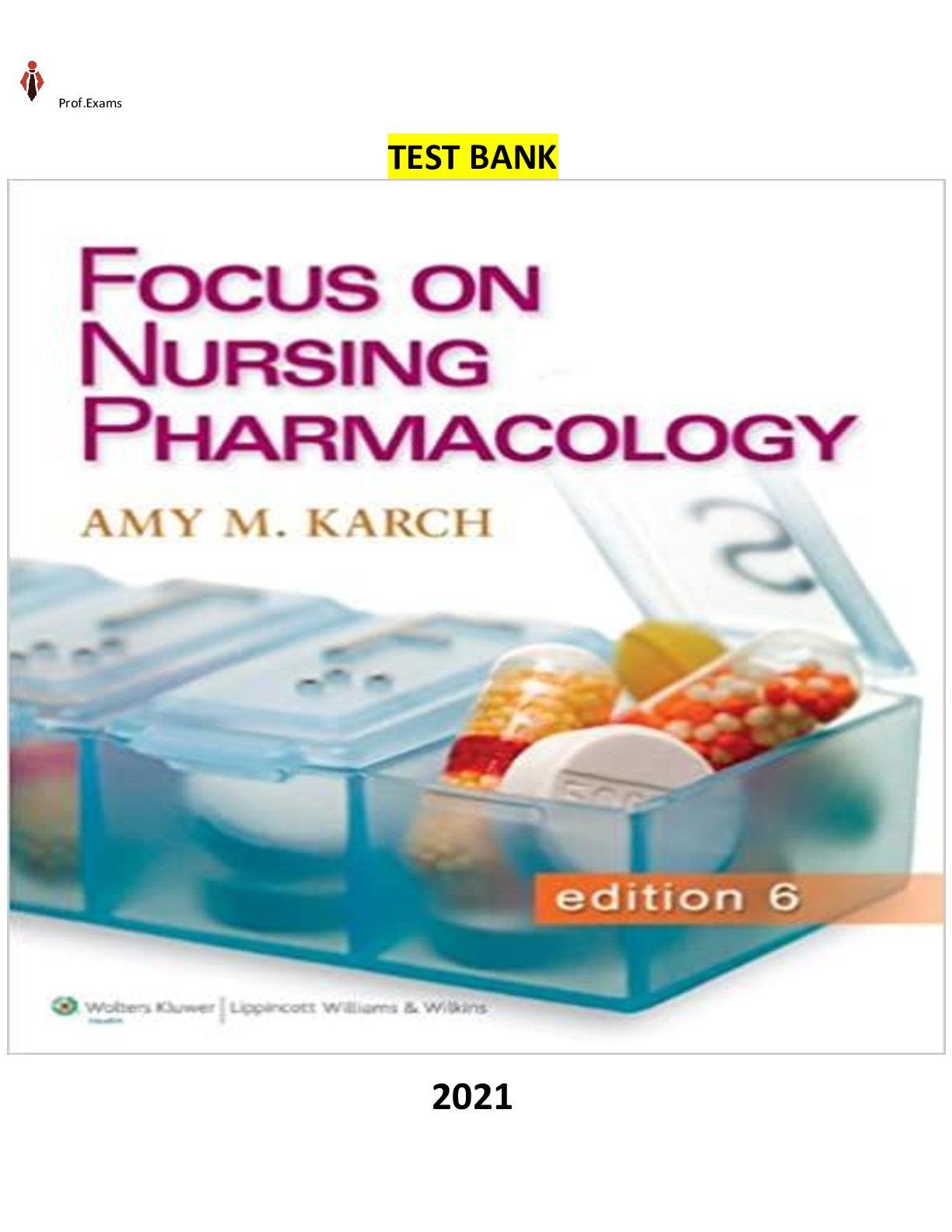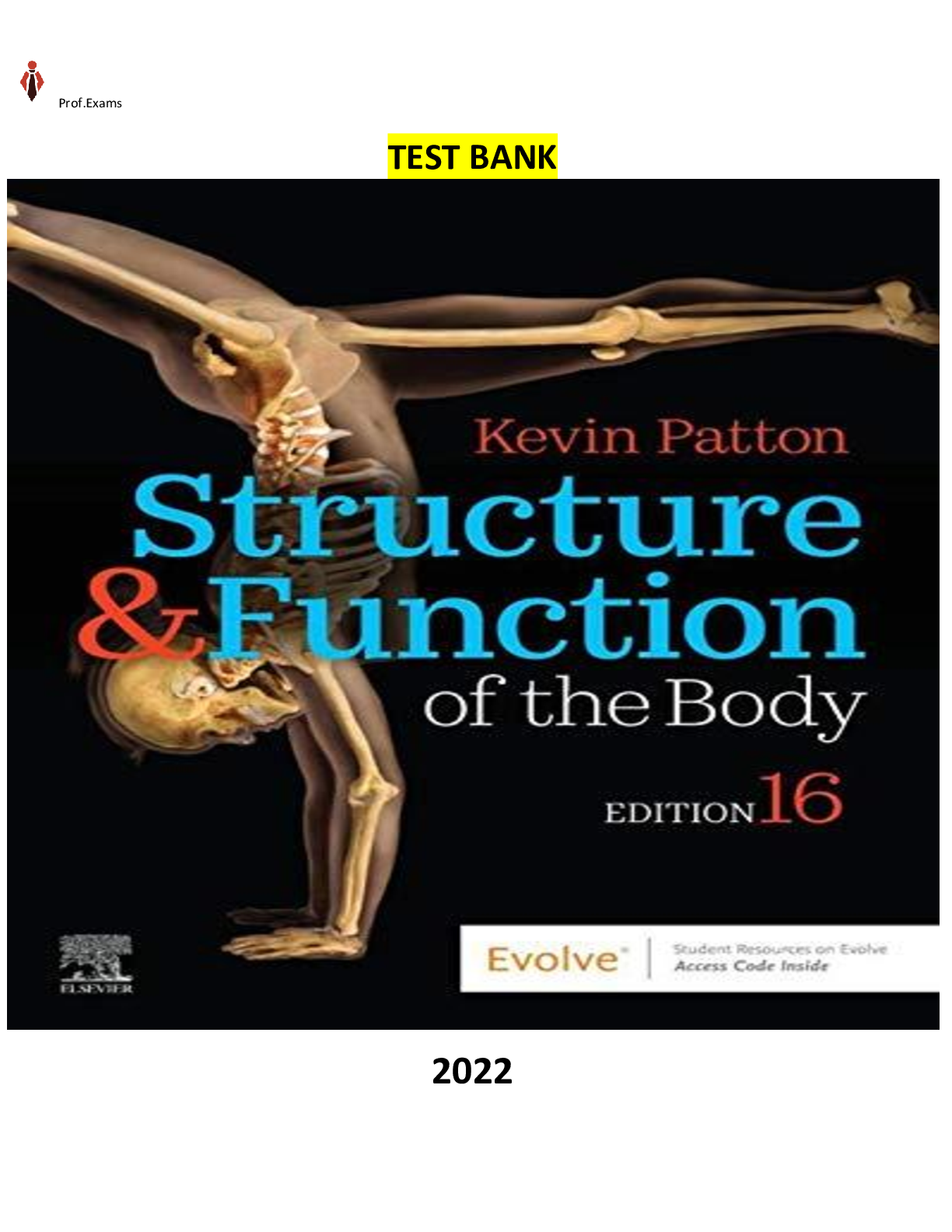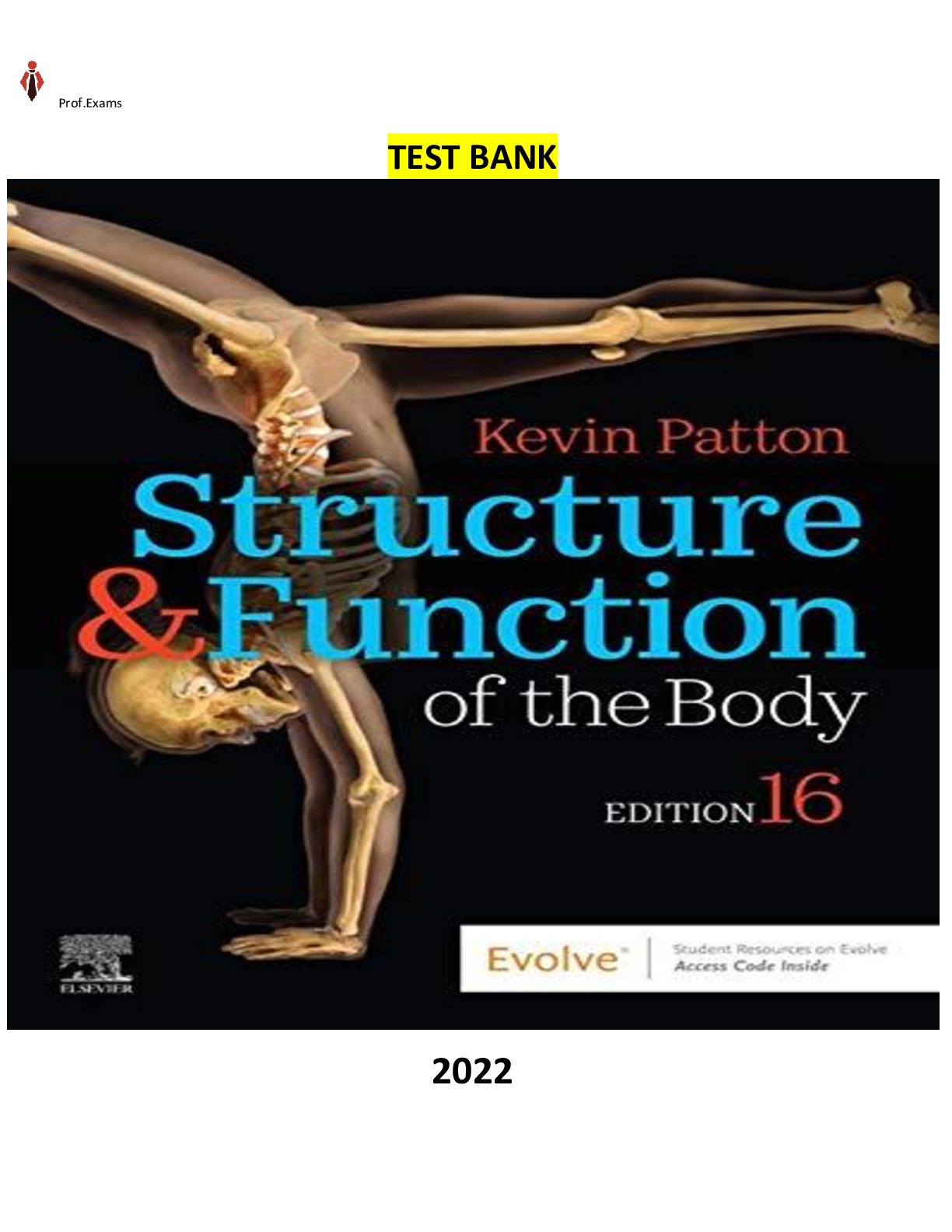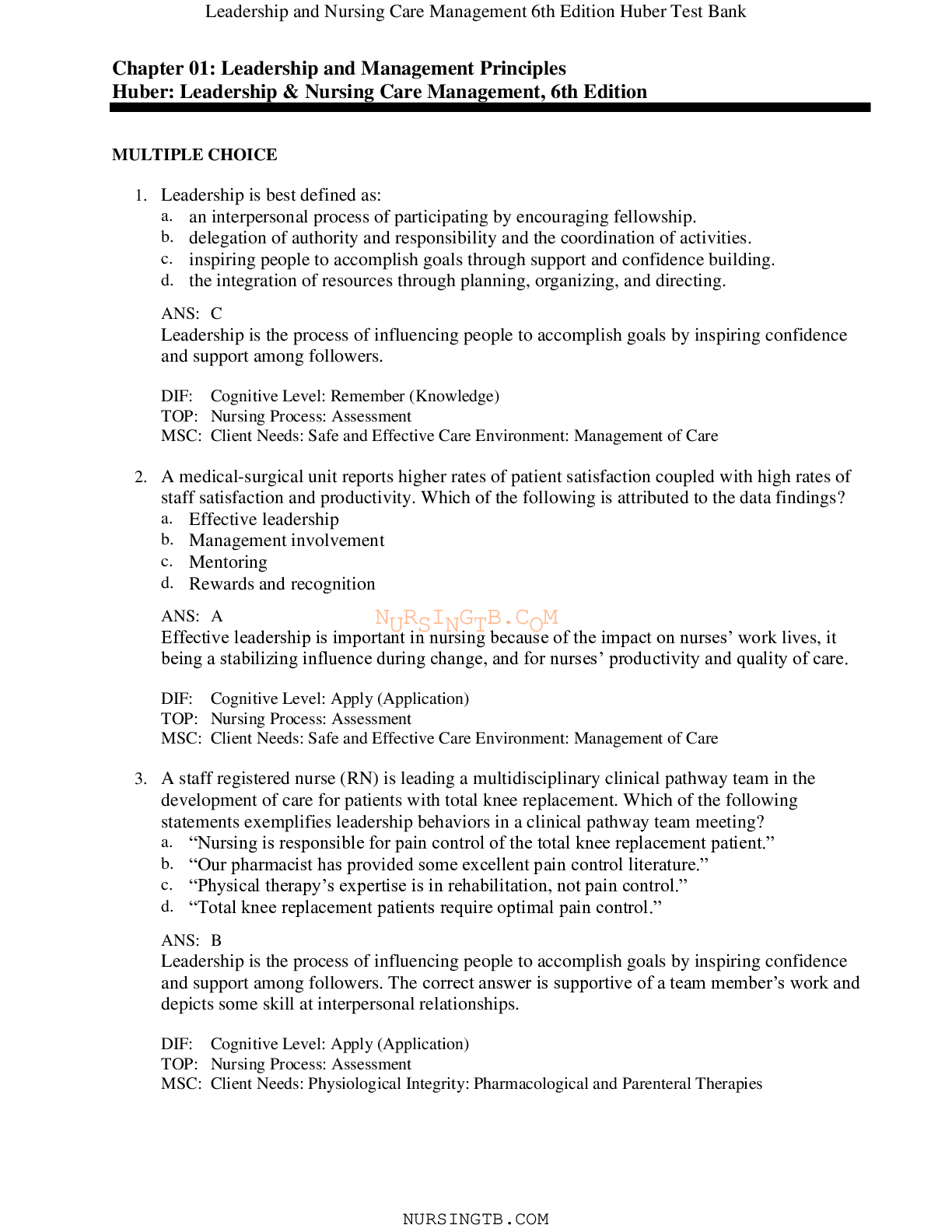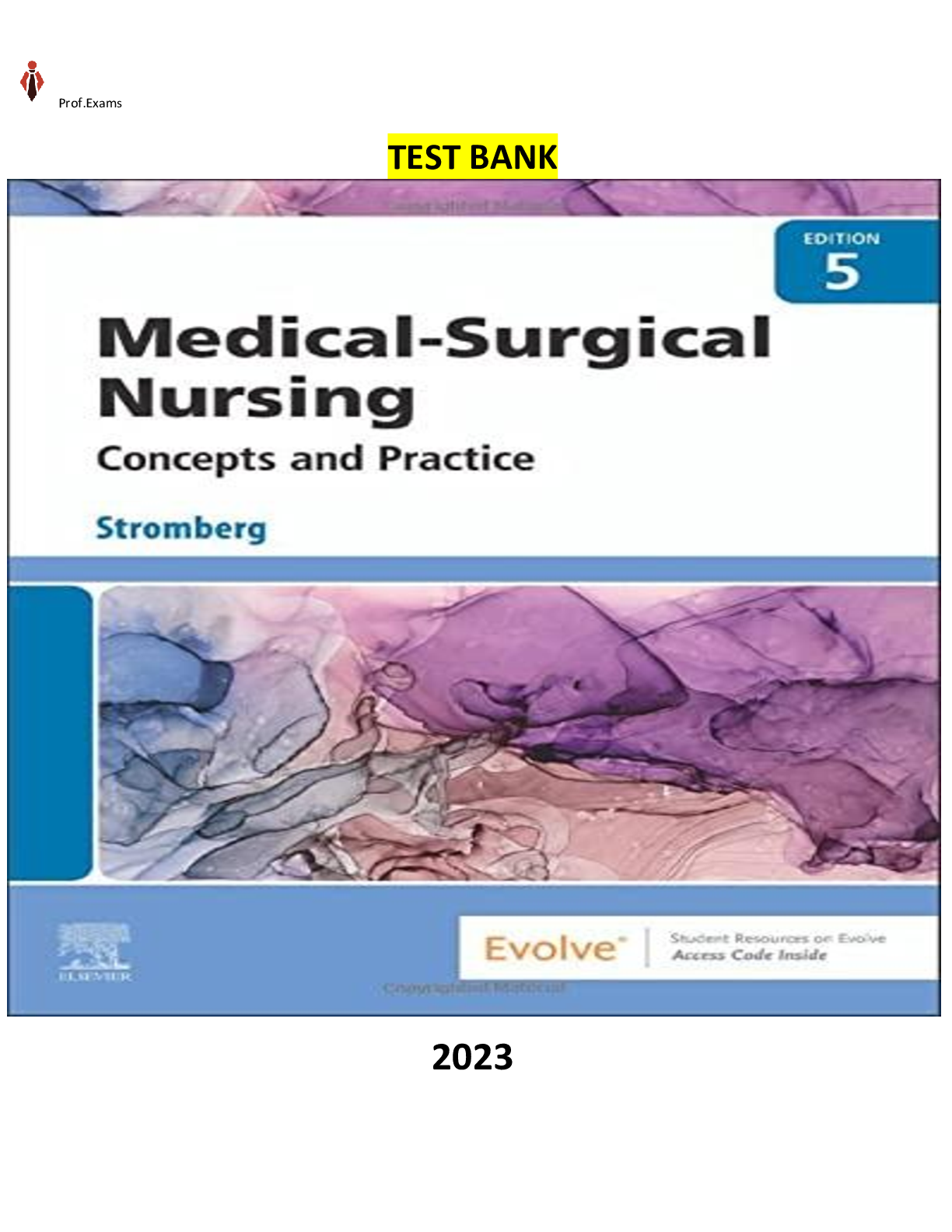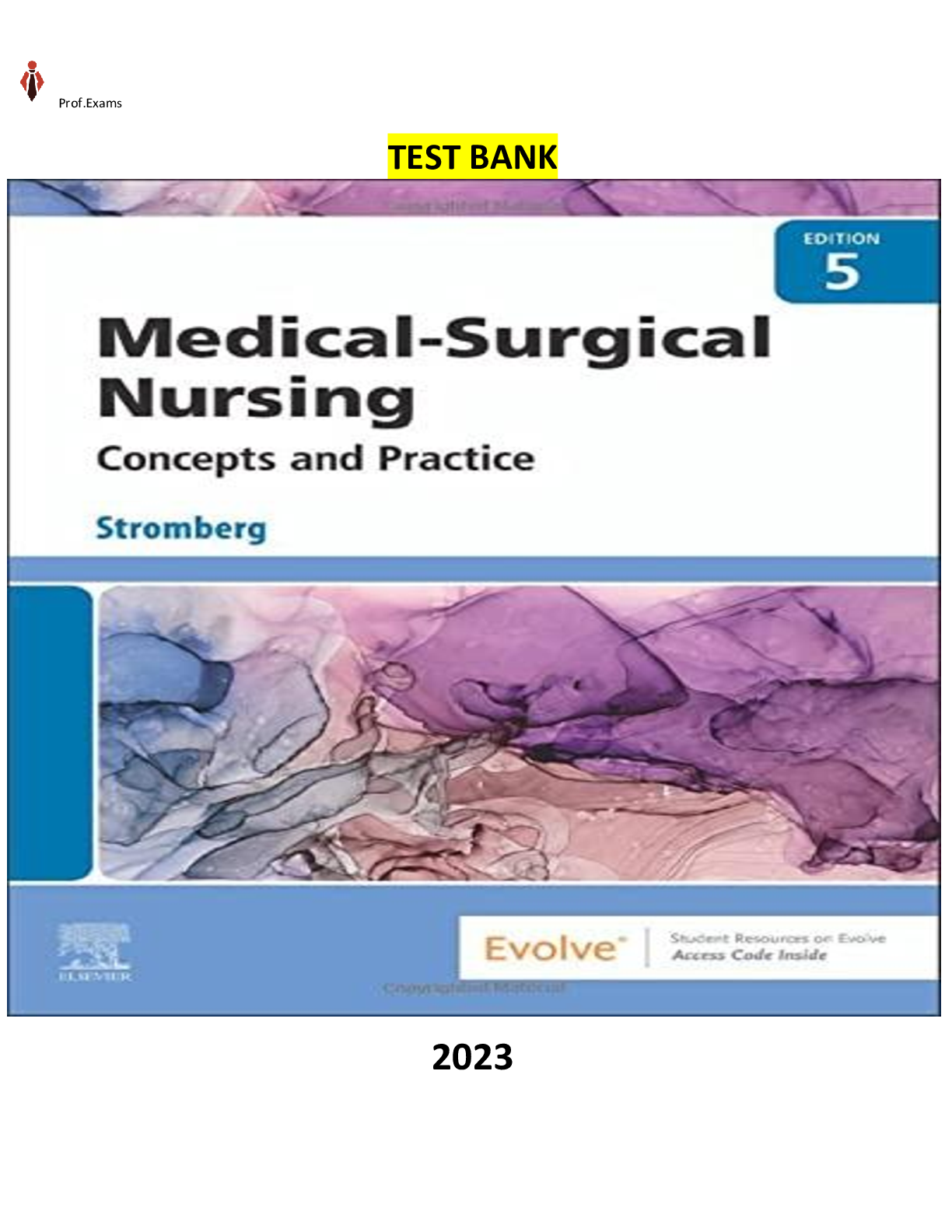*NURSING > TEST BANK > COMPLETE - Elaborated Test Bank for Leadership and Nursing Care Management Ed.7 by Diane Huber & M. (All)
COMPLETE - Elaborated Test Bank for Leadership and Nursing Care Management Ed.7 by Diane Huber & M. Lindell Joseph. ALL Chapters Included - 1 to 26- 250 pages of Questions and Answers for 2023
Document Content and Description Below
COMPLETE - Elaborated Test Bank for Leadership and Nursing Care Management Ed.7 by Diane Huber & M. Lindell Joseph. ALL Chapters Included - 1 to 26- 250 pages of Questions and Answers for 2023 COMPLE... TE - Elaborated Test Bank for Leadership and Nursing Care Management Ed.7 by Diane Huber & M. Lindell Joseph TABLE OF CONTENTS PART 1: LEADERSHIP 1. leadership and management principles 1.1. Leadership and care management differentiated 1.2. Leadership overview 1.3. Background related to leadership 1.4. Leadership: five interwoven aspects 1.5. Leadership theories 1.6. Contemporary leadership: interactional and relationship-based 1.7. Effective leadership 1.8. Management overview 1.9. Background: the management process 1.10. Contemporary management theories 1.11. Leadership and management implications 1.12. Current issues and trends 2. CHANGE AND INNOVATION 2.1. Theoretical framework 2.2. Change theories/models 2.3. The process of change 2.4. Leadership and change 2.5. Power and politics 2.6. Innovation theory 2.7. Leadership and management implications 2.8. Current issues and trends 2.9. Best practice suggestions for nurse leaders 3. Organizational Climate and Culture 3.1. Research 3.2. Leadership and management implications 3.3. Current issues and trends 4. Managerial Decision-Making 4.1. Decision-making process 4.2. Clinical decision-making 4.3. Managerial and organizational decision-making 4.4. Decision-making tools 4.5. Leadership and management implications PART 2: PROFESSIONALISM 5. Managing Time and Stress 5.1. Components of workplace stress 5.2. Time management strategies for nurse leaders 5.3. Resilience 5.4. Leadership and management implications 6. Role Management 6.1. Leadership and management implications 6.2. Current issues & trends 7. Legal and Ethical Issues 7.1. Ethical components 7.2. Legal perspectives 7.3. Legal definitions 7.4. The legal system and sources of law 7.5. Licensure, multi-state, and distance practice 7.6. Legal documents and the nurse 7.7. Leadership and management implications PART 3: COMMUNICATION LEADERSHIP 8. Communication Leadership 8.1. Communication theories and models 8.2. Communication to facilitate change: Kotter 8.3. Organizational culture and climate 8.4. Leadership and management implications 8.5. Current communication issues and trends 9. Team Building and Working with Effective Groups 9.1. Why groups are formed 9.2. Advantages of groups 9.3. Disadvantages of groups 9.4. Group decision-making 9.5. Team building 9.6. Working with teams 9.7. Committees 9.8. Effective meetings 9.9. Constructive group roles and behaviors 9.10. Disruptive roles and behaviors 9.11. Managing disruptive behavior in groups 9.12. Leadership and management implications 10. Power and Conflict 10.1. Power 10.2. Sources of power 10.3. Social capital in nursing 10.4. Nursing theory and power 10.5. Political power 10.6. Powerlessness/oppression 10.7. Authority and influence 10.8. Leadership and management implications 10.9. Conflict 10.10. Conflict management 10.11. Levels of conflict 10.12. Conflict management 10.13. Bullying and disruptive behavior 10.14. Conflict scales 10.15. Conflict management and alternative dispute resolution 10.16. Conflict resolution 10.17. Leadership and management implications 11. Workplace Diversity and Inclusion 11.1. Creating diversity and inclusion in the workplace 11.2. Leadership and management implications PART 4: KNOWLEDGE OF THE HEALTH CARE ENVIRONMENT 12. Organizational Structure 12.1. Key theories of organizations as social systems 12.2. Key organizational design concepts 12.3. Organizational charts 12.4. Organizational shapes 12.5. Structural power 12.6. Leadership and management implications 13. Decentralization and Governance 13.1. Leadership and management implications 14. Strategic Management 14.1. Elements of a strategic plan 14.2. Implementation of the strategic plan 14.3. Leadership and management implications 14.4. Current issues and trends 15. Professional Practice Models 15.1. Professional practice models 15.2. Structures and processes that support care delivery models 15.3. Care delivery models 15.4. Evolving models 15.5. Innovative models 15.6. Leadership and management implications 15.7. Current issues and trends 16. Case and Population Health Management 1.1. Case management 1.2. Disease management 1.3. Leadership and management implications 17. Nursing Leadership for Evidence-Based Practice 17.1. Steps for performing evidence-based practice 17.2. Implementing and sustaining evidence-based practice changes 17.3. An evidence-based practice exemplar 17.4. Organizational infrastructure and context 17.5. Leadership roles in promoting evidence-based practice 17.6. Leadership and management implications 18. Quality and Safety 18.1. Health care quality in a new millennium 18.2. Leadership and management implications 18.3. Industrial models of quality 18.4. Standards of quality 18.5. Quality and safety performance improvement models 18.6. Costs associated with waste in health care 19. Measuring and Managing Outcomes 19.1. Influences on outcomes 19.2. Measurement of outcomes 19.3. Elements of outcomes research 19.4. Leadership and management implications 19.5. Current issues and trends PART 5: BUSINESS SKILLS 20. Workplace Violence and Incivility 20.1. Leadership and management implications 21. Nursing Workforce Staffing and Management 21.1. Framework for staffing management 21.2. Strategies influencing staffing management 21.3. Leadership and management implications 21.4. The staffing management plan 21.5. Organizational outcomes 22. Budgeting, Productivity and Costing Out Nursing 22.1. The budget processes 22.2. Tracking and monitoring of budgets 22.3. Leadership and management implications 22.4. Productivity 23. Performance Appraisal 23.1. Purpose of performance appraisals 23.2. Issues in performance management 23.3. Developing employees through the performance appraisal and review 23.4. Leadership and management implications 24. Emergency Management and Preparedness 24.1. Transitioning theory into practice for all-hazards preparedness 24.2. Getting started: first steps 24.3. Crisis standards of care 24.4. Leadership and management implications 24.5. Current issues and trends 25. Nursing Informatics for Leaders in Clinical Nursing 25.1. Current issues and trends 25.2. Leadership and management implications 26. Marketing 26.1. Key marketing concepts 26.2. Leadership and management implications SAMPLE QUESTIONS 1. Leadership is best defined as: a. an interpersonal process of participating by encouraging fellowship. b. delegation of authority and responsibility and the coordination of activities. c. inspiring people to accomplish goals through support and confidence building. d. the integration of resources through planning, organizing, and directing. ANS: C Leadership is the process of influencing people to accomplish goals by inspiring confidence and support among followers. DIF: Cognitive Level: Remember (Knowledge) TOP: Nursing Process: Assessment MSC: Client Needs: Safe and Effective Care Environment: Management of Care 2. A medical-surgical unit reports higher rates of patient satisfaction coupled with high rates of staff satisfaction and productivity. Which of the following is attributed to the data findings? a. Effective leadership b. Management involvement c. Mentoring d. Rewards and recognition ANS: A Effective leadership is important in nursing because of the impact on nurses’ work lives, it being a stabilizing influence during change, and for nurses’ productivity and quality of care. DIF: Cognitive Level: Apply (Application) TOP: Nursing Process: Assessment MSC: Client Needs: Safe and Effective Care Environment: Management of Care 3. A staff registered nurse (RN) is leading a multidisciplinary clinical pathway team in the development of care for patients with total knee replacement. Which of the following statements exemplifies leadership behaviors in a clinical pathway team meeting? a. “Nursing is responsible for pain control of the total knee replacement patient.” b. “Our pharmacist has provided some excellent pain control literature.” c. “Physical therapy’s expertise is in rehabilitation, not pain control.” d. “Total knee replacement patients require optimal pain control.” ANS: B Leadership is the process of influencing people to accomplish goals by inspiring confidence and support among followers. The correct answer is supportive of a team member’s work and depicts some skill at interpersonal relationships. DIF: Cognitive Level: Apply (Application) TOP: Nursing Process: Assessment MSC: Client Needs: Physiological Integrity: Pharmacological and Parenteral Therapies 4. Which of the following is true of management activities? a. Inspiring a vision is a management function. b. Management is focused on task accomplishment. c. Management is more focused on human relationships. d. Management is more important than leadership. ANS: B Management is focused on task accomplishment. DIF: Cognitive Level: Remember (Knowledge) TOP: Nursing Process: Assessment MSC: Client Needs: Safe and Effective Care Environment: Management of Care 5. During a staff meeting, a group of RNs has complained that medications are not arriving to the unit in a timely manner. The nurse manager suggests that the group resolve this issue through the development and work of a multidisciplinary team led by one of these RNs. This scenario demonstrates: a. adaptation. b. empowerment. c. flexibility. d. relationship management. ANS: B Empowerment is the giving of authority, responsibility, and the freedom to act. In this situation, the manager has given authority, responsibility, and the freedom to act in the investigation and resolution of this issue. DIF: Cognitive Level: Apply N(ApRplicaItionG) B.C M TOP: Nursing Process: Assessment MSC: Client Needs: Safe and Effective Care Environment: Management of Care 6. A nurse is caring for an elderly patient who was admitted after sustaining a fall at home. When creating a care plan for the patient, she requests that the doctor order a home health visit to assess for home safety and medication compliance. In addition, the nurse is concerned about the nutrition of the patient and requests a dietitian evaluation. The nurse is demonstrating which of the following leadership skills? a. Care provider b. Business principles c. Care coordination d. Change management ANS: C Care coordination is the delivery of nursing services that involves the organization and coordination of complex activities. The nurse uses managerial and leadership skills to facilitate delivery of quality care. DIF: Cognitive Level: Apply (Application) TOP: Nursing Process: Planning MSC: Client Needs: Physiological Integrity: Reduction of Risk Potential 7. Interpersonal communication and the ability to apply are two critical skills every nurse needs to enhance professional practice. a. vision U S N T O b. supervision c. delegation d. problem solving ANS: D Every nurse needs two critical skills to enhance professional practice. One is a skill at interpersonal relationships. This is fundamental to leadership and the work of nursing. The second skill is applying the problem-solving process. This involves critical thinking, problem identification, and the development of objectivity. DIF: Cognitive Level: Remember (Knowledge) TOP: Nursing Process: Assessment MSC: Client Needs: Safe and Effective Care Environment: Management of Care 8. Good leaders need to be able to demonstrate an intuitive skill of empathy and expressiveness when dealing with others in the workplace. This requires sensitivity and awareness of the emotions and moods of others and is known as: a. social awareness. b. self-awareness. c. self-management. d. relationship management. ANS: A Social awareness is an intuitive skill of empathy and expressiveness in being sensitive and aware of the emotions and moods of others. DIF: Cognitive Level: Remember (Knowledge) TOP: Nursing Process: AssessNmenRt I G B.C M MSC: Client Needs: Safe and Effective Care Environment: Management of Care 9. The personal leadership skill for nurses that consists of self-awareness, discipline, motivation, social awareness, and relationship management is known as what? a. Leadership. b. Management. c. Emotional intelligence d. Vision ANS: C Among the important personal leadership skills for nurses is emotional intelligence (EI). EI traits are emotional factors consisting of five defining attributes: self-awareness, self-regulation or discipline, motivation, social awareness, and relationship management. DIF: Cognitive Level: Remember (Knowledge) TOP: Nursing Process: Implementation MSC: Client Needs: Safe and Effective Care Environment: Management of Care 10. are vital to good leaders because they are able to take the vision of the leader and achieve the determined goals. a. Managers b. Motivators c. Visionaries d. Followers ANS: D Without followers, there is no leadership. Followers are vital because they accept or reject the leader and determine the leader’s personal power. DIF: Cognitive Level: Remember (Knowledge) TOP: Nursing Process: Assessment MSC: Client Needs: Safe and Effective Care Environment: Management of Care 11. The best leadership style for unfavorable conditions is: a. leader–member relations. b. task-oriented structure. c. position power. d. laissez-faire. ANS: B The need for task-oriented leaders occurs when the situation is extreme. The best leadership style for unfavorable conditions is task-oriented. DIF: Cognitive Level: Remember (Knowledge) TOP: Nursing Process: Assessment MSC: Client Needs: Safe and Effective Care Environment: Management of Care 12. Nursing management is defined as: a. delegation of authority and responsibility and the coordination of tasks. b. the integration of resources through planning, organizing, and directing. c. the process of influencing patients to accomplish goals. d. the coordination and integration of nursing resources by applying the management process to accomplish nursUing ScareNandTservicOe goals and objectives. ANS: D The coordination and integration of nursing resources by applying the management process to accomplish nursing care and service goals and objectives is the definition of nursing management. DIF: Cognitive Level: Remember (Knowledge) TOP: Nursing Process: Assessment MSC: Client Needs: Safe and Effective Care Environment: Management of Care 13. A nursing unit has demonstrated lower patient satisfaction scores during the last quarter. The manager of the unit has formed a small team to set long- and short-term goals for the unit with action plans to increase patient satisfaction. This is an example of which management process? a. Planning b. Organizing c. Coordinating d. Controlling ANS: A Planning is the managerial function of selecting priorities, results, and methods to achieve results. DIF: Cognitive Level: Apply (Application) TOP: Nursing Process: Planning MSC: Client Needs: Safe and Effective Care Environment: Management of Care 14. A nursing unit has discovered a series of medication errors with regard to a particular computerized physician order set and the calculation within the order. The unit manager has a theory on changes that should be made within the order to decrease the confusion for nursing staff. However, the nurse manager realizes that changes would need to be made with pharmacy input as well as other nursing units within the facility and the multihospital system. Which of the following management theories is exemplified when the nurse manager considers the impact of change on the organization as a whole? a. Contingency theory b. Systems theory c. Complexity theory d. Chaos theory ANS: B Systems theory helps managers recognize their work as being embedded within a system. Managers use this theory to learn that changing one part of a system inevitably affects the whole system. DIF: Cognitive Level: Apply (Application) TOP: Nursing Process: Planning MSC: Client Needs: Physiological Integrity: Reduction of Risk Potential 15. The role of the is to provide leadership and direction for all aspects of nursing services with a focus on integrating the system and building a culture. a. nurse manager b. care provider c. nurse executive d. senior leader ANS: C NURSINGTB.COM The nurse executive’s role and functions concentrate on long-term administration of an institution or program that delivers nursing services, focusing on integrating the system and building a culture. DIF: Cognitive Level: Remember (Knowledge) TOP: Nursing Process: Assessment MSC: Client Needs: Safe and Effective Care Environment: Management of Care 16. The postoperative patient with anterior cervical laminectomy is complaining of tightness in his throat. His voice is raspy. The staff nurse asks the unit secretary to page Dr. Julio stat. This is an example of leadership. a. authoritarian b. democratic c. laissez-faire d. servant ANS: A Authoritarian leadership uses directive and controlling behaviors in which the leader determines policies and makes decisions in isolation. The leader orders subordinates to carry out the tasks or work. This style is helpful in crisis situations. DIF: Cognitive Level: Apply (Application) COMPLETE - Elaborated Test Bank for Leadership and Nursing Care Management Ed.7 by Diane Huber & M. Lindell Joseph. ALL Chapters Included - 1 to 26- 250 pages of Questions and Answers for 2023. [Show More]
Last updated: 8 months ago
Preview 1 out of 255 pages
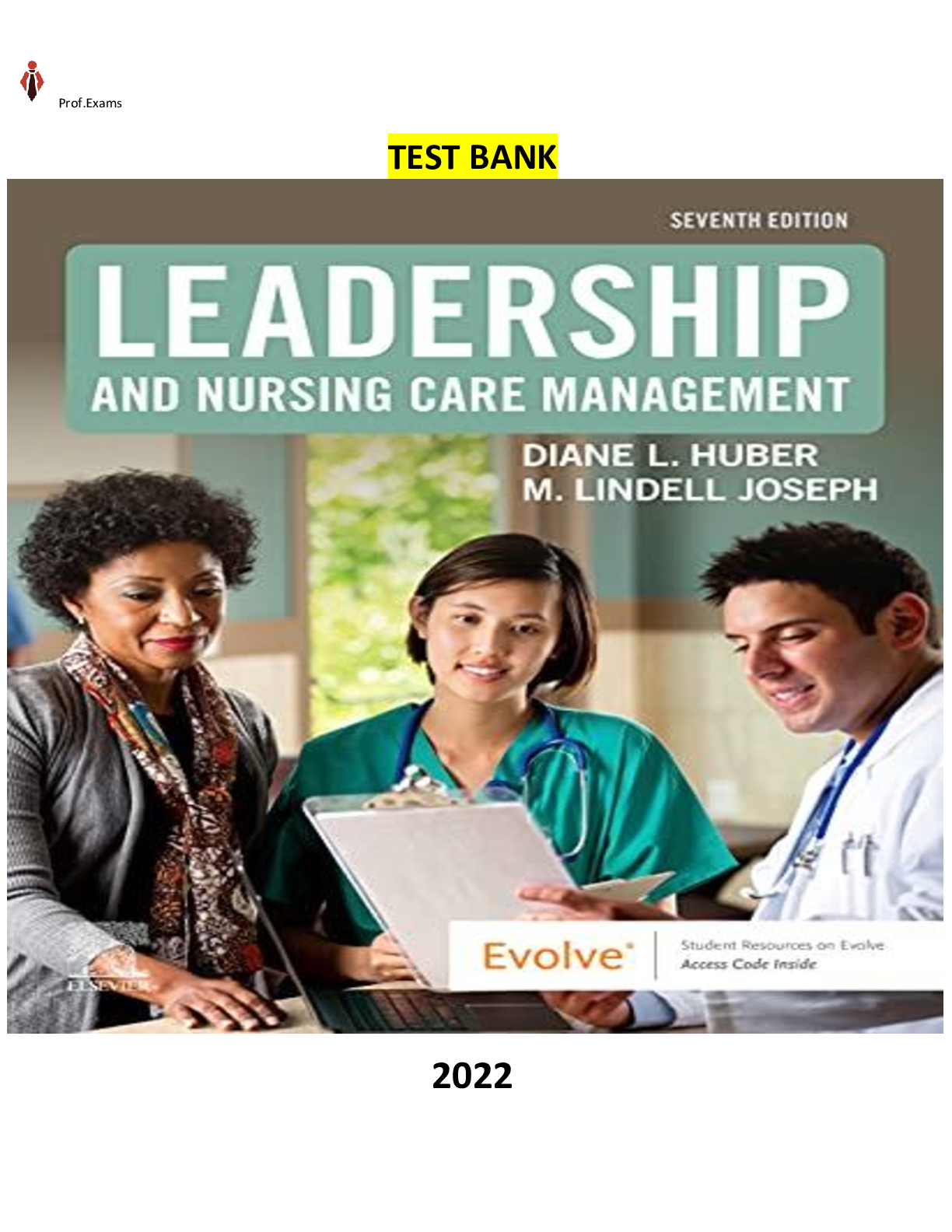
Reviews( 0 )
Document information
Connected school, study & course
About the document
Uploaded On
Apr 07, 2023
Number of pages
255
Written in
Additional information
This document has been written for:
Uploaded
Apr 07, 2023
Downloads
0
Views
42


